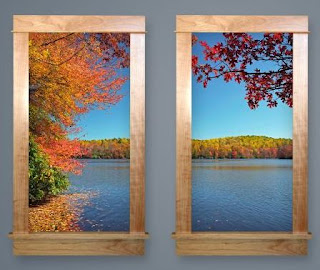
Film created a new sort of window, a window that showed a different view of the world. Film had the ability to show not only “reality” as the filmmaker sees it, but film could also show fiction, an aspect of human life that had not yet been viewed in such a “realistic” sense. And then after film there was television, a window that brought the entire world as well as entire worlds of thought right into everyone’s living room. Television was so pervasive and so adept at bringing the world home, it was hard to imagine another device that could bring more “real life” inside. The computer screen, though, is a window that has a much greater ability then the television to bring “reality” home. You can view films and television shows through your computer, any image or piece of art, and just about any piece of information or misinformation. But the computer has also created a major shift in our view of reality through the onset of “virtual worlds” and “virtual reality.”
Anne Friedberg comments on how the window, or the virtual window, seems to be growing increasingly transparent. The distance between the viewing public and the reality shown to them is becoming increasingly short. As Anne Friedberg says, “Virtual images radically transformed the twentieth-century understanding of reality, and yet most virtual images were seen in frames and through frames. Which technologies will break through the frame and have us climb through the metaphoric window?” (Friedberg, page 348) This passage seems to ask the key question. When will windows come full circle? Windows began without glass and it seems that soon we will be able to go through them again.
Windows are close to coming full circle, from something to let the world in (glassless widows), to something though which we see the world (glass windows), to something through which we view an individual’s idea of the world (film, TV), to something through which we see a virtual reality (computer screen). All of these types of windows have frames, but only one of them allows you to go through it into the world it shows. But when will this virtual reality we see through our computers become yet another “real” world that we can walk around in. Already there are people who seem to completely live in these virtual worlds as they often seem more real that the world outside our glass windows. When will the frame be taken away? Its only a matter of time before we will be able to step through this virtual window and into the new reality. “Is the ‘age of windows’ – and by extension, the age of screens – reaching…its end?” (Friedberg, 349)
3 comments:
I never realized how much a window can open imagination whether it is real or fake. We as humans have moved from just a hole in a building to a screen that can reveal people's wildest dreams. It is a little unusual to think about what might come next. I am always wondering if eventually we will be able to react in the virtual world. Does this mean in ten years we will be able to interact with people? There are so many windows sitting right in front of us, we do not even stop to think what they can and have done.
What struck me most about your response to the reading is the idea of the inevitable end of the "age of windows". I agree that the logical progression of technology will see the removal of that final barrier between the viewer and the reality that exists on the other side of his screen. Although what intrigues me the most is how we will gradually begin to remove the barriers between ourselves and the target world. Will the first thing to go be the mouse and the keyboard, to be replaced by software that can interpret brain waves in the same way that our physical limbs do now?
The technological possibilities are endless; how will we slowly dismantle the wall between reality and well... our very dreams? What if it comes to the point where there is no longer any need for technology at all, and it simply becomes the matter of stepping through a glassless window?
The idea is immense in nature, and the gradual return to basic patterns has been observed before as technology reaches it's "apex"... But that's besides the point I think. The point being that windows are well on their way to becoming doors that open onto worlds previously only accessible by visual means.
-Matt Smith
An excellent analysis of windows' future potentiality -- possibly along the lines of "engagement" rather than subject vs. object in a relationship of looking and looked at.
Jason Pine
Post a Comment